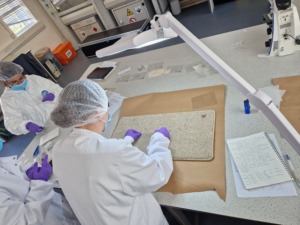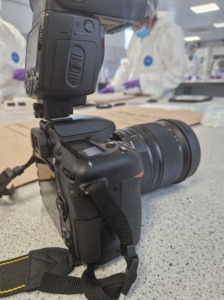Trace Evidence – How the smallest clues can make the largest difference at a crime scene.
30/03/2023

When arriving at a crime scene, there are often signs or physical evidence such as hairs, fibres or shards of material that are often integral to solving how a crime was committed or providing critical evidence if required at a court trial.
The Office for National Statistics (ONS) have tracked the rise in violent crime across the United Kingdom (UK). Since its lowest levels in 2012/13, there has been a dramatic increase of over 600,000 reports per year as last reported in September 2022.
This means that not only are police forces being stretched in their need for both detective and crime scene investigation (CSI) units but also the rise of both emergency service and independent forensic services personnel, who provide invaluable support to recover, examine and present evidence at trial.
Cranfield Forensic Institute (CFI) have been integral in creating the next generation of forensic scientists, investigators and experts. This is underpinned by utilising our breadth of academic staff who are currently practicing in both public and professional services.
In early March 2023 CFI ran the Trace Evidence module. The course ran over a five-day period and included two full days of hands-on work within the dedicated laboratory space at the Cranfield Campus.
The module focuses on trace evidence types such as hairs, fibres and glass that are transferred between surfaces upon contact and non-contact.
What is Trace Evidence?
The transfer of trace evidence and their analysis within forensic science were first discovered and documented by Dr Edmund Locard in early 20th century France.
The identification and analysis of the type and numbers of a particular trace evidence type can be utilised by trace evidence experts to establish if contact between clothing and surfaces has occurred and what type of contact this was to establish links between people and places.
An expert in each of the disciplines within the Trace Evidence arena of forensic science, for example within hairs/fibres/glass analysis, will be able to establish common characteristics of these evidence types, complete experiments and analyse databases in order to establish transfer and persistence of these evidence types within the case scenarios provided.

Students were split into groups and were given the task of investigating and extracting trace evidence from carpet strips
As a very popular module at CFI, it sits within the Forensic Modular Programme. This makes it an elective choice for the majority of the Master’s courses offered at CFI.
The module allows you to work methodically through the process of how to collect evidence or materials of very small scale such as fibres, hairs or blood flecks.
Students started the week with theory-based lectures on the processes, ethics and details of evidence recovery, they were then given a small scale potential crime scene, where they could investigate evidence, analyse any trace materials and finish the module by building a final report which could be used at trial.
The course was attended by 14 students across a number of our MSc’s including the Forensic Investigation MSc.
“It’s great to be really hands-on and do a lot of the things we’ve learnt in the theory sessions. This module really builds on base-line information learnt at undergraduate level”
Reece Smith (Current Forensic Investigation MSc student)

Uncovering the smallest pieces of evidence can be the difference between a verdict at a court trial
Attendees of the course have benefitted since CFI moved home to the Cranfield Campus in 2020. The multi-million-pound investment allowed the University to build dedicated resources for laboratories, teaching spaces and student break-out areas.
It enabled to have both a space to collect the evidence, but also to be transferred and investigated under a microscope in a separate sterile space.
The module leader, Laura Hugh is a practicing Forensic Biologist and will be launching the brand-new Forensic Biology MSc in October 2023.
Discussing the necessity for Forensic Biology expertise and how the Trace Evidence module provides the knowledge to create real-world changes.
“As a forensic biologist we are directly interpreting evidence from crimes, in light of case scenarios in an effort to solve a crime and therefore making a real-life difference within the criminal justice system to help a victim and victim’ family or exonerate a suspect in other cases.”
As of February 2023, there were roughly 5000 active forensic professionals in the UK with 200 graduates being employed each year (source Forensic Science Degrees: The Higher Education Perspective).
Choosing the right role and location is important, but as a leading university in forensic postgraduate degrees. Cranfield is attracting not only recent undergraduates from the UK, but international students from Asia, Europe and America.
“I study and work in Belgium, we don’t really have this type of course. It’s a very unique course, there aren’t many similar courses out there. Also, the elective modules that I could take that aligned with this course were very applicable to me, such as the textile and soil research”
(Griet Kockelkoren, Short Course Student)
This proves that the growing need for forensic expertise is apparent not just in the UK, but worldwide.
The rise of crime-based TV shows and the subsequent interest in further forensic training means this is a growing area is only going to become more popular.
It’s good news for forensic service providers and police forces as they look to kerb the incline in violent crime and bring the perpetrators to court.
You can find out more about Cranfield University’s Forensic Institute here, and build your own career in the world of investigation and justice.
Categories & Tags:
Leave a comment on this post:
You might also like…
Automotive Engineering: From student to hypercar innovation at Rimac
We sat down with recent graduate Thomas Perrin, to discuss how his year on the MSc in Automotive Engineering at Cranfield University propelled him from the lecture hall directly into the ...
What this year at Cranfield really meant to me
Every Cranfield journey is unique. In this alumni reflection, Zachea Scicluna shares what her year at Cranfield truly meant, from facing uncertainty to gaining hands-on experience in industry-backed projects. I’ve been reflecting (and delaying) ...
Preparing for assignments and exams?
Sorry! We know it seems a bit mean to mention the exams in January rather than looking forward to the break before it! However, we know many of you will be thinking about your forthcoming ...
Screening for FTSE 100 companies on Bloomberg
So you’re researching an index and need some data on its constituent companies? Bloomberg’s Equity Screening tool makes light work of this, not just for the FTSE, but for indices, exchanges and sectors worldwide. Type EQS ...
Accelerating my future: How Cranfield put me on the fast track to automotive safety innovation
Hello! I’m Michaela Kaiser, and I’m thrilled to share my journey studying abroad. I’m from Calgary, Canada, and I recently graduated from Cranfield’s MSc Automotive Engineering course. My path to Cranfield ...
From Myanmar to Cranfield: My path to Renewable Energy
As someone who is passionate about sustainability, my career goal is to build a path in the renewable energy sector. My aspirations comes from the benefits of developing sustainable energy sources and ensuring energy ...






